Accounting Standards in India and Sri Lanka: A Comparative Analysis
VerifiedAdded on 2023/06/12
|12
|4244
|264
Literature Review
AI Summary
This assignment provides a comparative analysis of the financial accounting standards in India and Sri Lanka, focusing on the similarities, differences, pros, and cons of each system. In India, the primary standard is the Indian Accounting Standard (Ind AS), which aligns with International Financial Reporting Standards (IFRS) and is overseen by the Accounting Standards Board (ASB) under the Institute of Chartered Accountants of India (ICAI). Sri Lanka, on the other hand, adopts financial reporting standards issued by the International Accounting Standards Board (IASB) through the Institute of Chartered Accountants of Sri Lanka, with Sri Lanka Accounting Standards (SLFRS and LKAS) mirroring IFRS. The report highlights convergences in areas like business combinations and share-based payments, as well as divergences in accounting policies and related party disclosures. While both countries aim for transparency and comparability, limitations exist, such as the inflexibility of standards and challenges in balancing alternatives. Desklib offers a platform for students to access this assignment and other study resources.
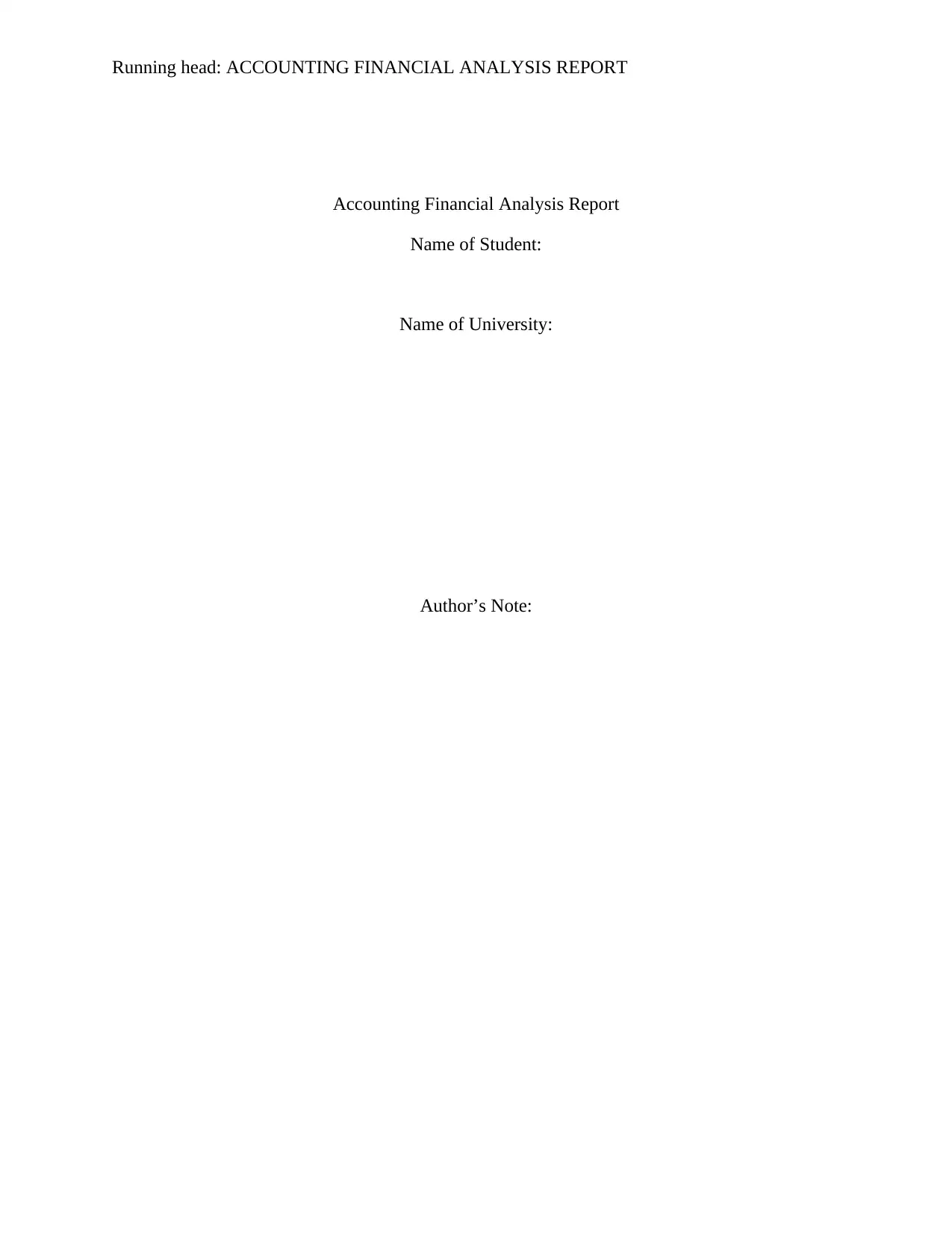
Running head: ACCOUNTING FINANCIAL ANALYSIS REPORT
Accounting Financial Analysis Report
Name of Student:
Name of University:
Author’s Note:
Accounting Financial Analysis Report
Name of Student:
Name of University:
Author’s Note:
Paraphrase This Document
Need a fresh take? Get an instant paraphrase of this document with our AI Paraphraser
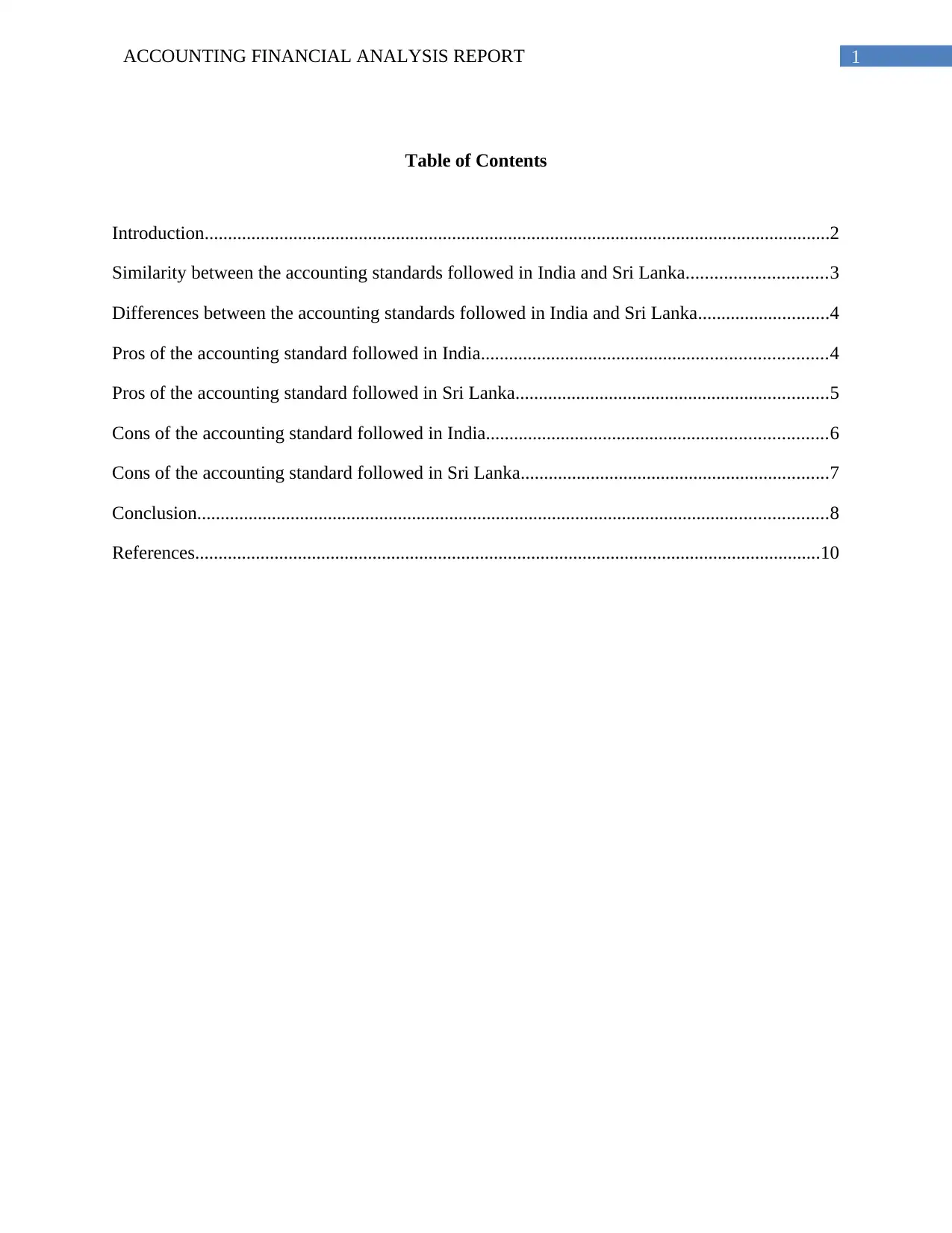
1ACCOUNTING FINANCIAL ANALYSIS REPORT
Table of Contents
Introduction......................................................................................................................................2
Similarity between the accounting standards followed in India and Sri Lanka..............................3
Differences between the accounting standards followed in India and Sri Lanka............................4
Pros of the accounting standard followed in India..........................................................................4
Pros of the accounting standard followed in Sri Lanka...................................................................5
Cons of the accounting standard followed in India.........................................................................6
Cons of the accounting standard followed in Sri Lanka..................................................................7
Conclusion.......................................................................................................................................8
References......................................................................................................................................10
Table of Contents
Introduction......................................................................................................................................2
Similarity between the accounting standards followed in India and Sri Lanka..............................3
Differences between the accounting standards followed in India and Sri Lanka............................4
Pros of the accounting standard followed in India..........................................................................4
Pros of the accounting standard followed in Sri Lanka...................................................................5
Cons of the accounting standard followed in India.........................................................................6
Cons of the accounting standard followed in Sri Lanka..................................................................7
Conclusion.......................................................................................................................................8
References......................................................................................................................................10
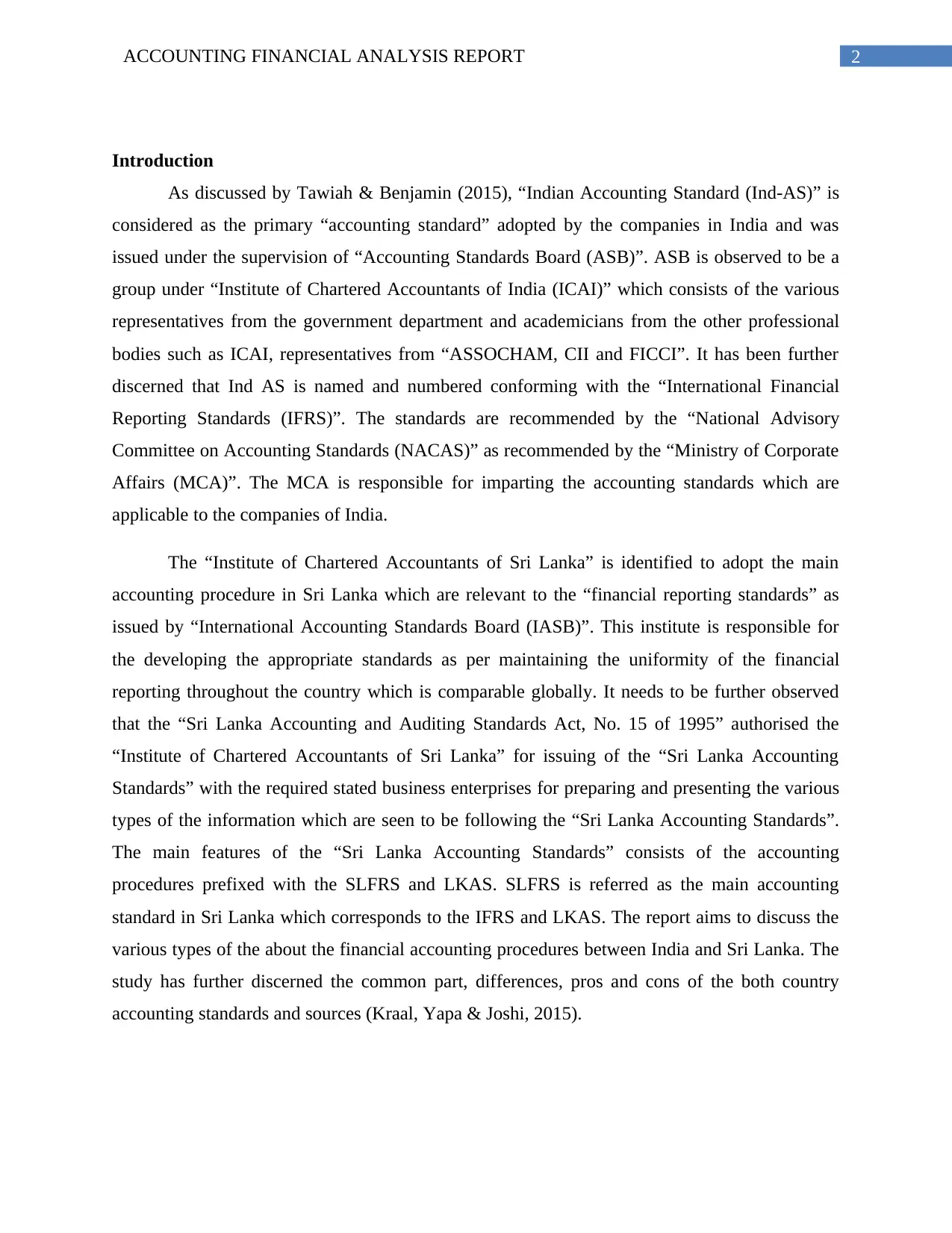
2ACCOUNTING FINANCIAL ANALYSIS REPORT
Introduction
As discussed by Tawiah & Benjamin (2015), “Indian Accounting Standard (Ind-AS)” is
considered as the primary “accounting standard” adopted by the companies in India and was
issued under the supervision of “Accounting Standards Board (ASB)”. ASB is observed to be a
group under “Institute of Chartered Accountants of India (ICAI)” which consists of the various
representatives from the government department and academicians from the other professional
bodies such as ICAI, representatives from “ASSOCHAM, CII and FICCI”. It has been further
discerned that Ind AS is named and numbered conforming with the “International Financial
Reporting Standards (IFRS)”. The standards are recommended by the “National Advisory
Committee on Accounting Standards (NACAS)” as recommended by the “Ministry of Corporate
Affairs (MCA)”. The MCA is responsible for imparting the accounting standards which are
applicable to the companies of India.
The “Institute of Chartered Accountants of Sri Lanka” is identified to adopt the main
accounting procedure in Sri Lanka which are relevant to the “financial reporting standards” as
issued by “International Accounting Standards Board (IASB)”. This institute is responsible for
the developing the appropriate standards as per maintaining the uniformity of the financial
reporting throughout the country which is comparable globally. It needs to be further observed
that the “Sri Lanka Accounting and Auditing Standards Act, No. 15 of 1995” authorised the
“Institute of Chartered Accountants of Sri Lanka” for issuing of the “Sri Lanka Accounting
Standards” with the required stated business enterprises for preparing and presenting the various
types of the information which are seen to be following the “Sri Lanka Accounting Standards”.
The main features of the “Sri Lanka Accounting Standards” consists of the accounting
procedures prefixed with the SLFRS and LKAS. SLFRS is referred as the main accounting
standard in Sri Lanka which corresponds to the IFRS and LKAS. The report aims to discuss the
various types of the about the financial accounting procedures between India and Sri Lanka. The
study has further discerned the common part, differences, pros and cons of the both country
accounting standards and sources (Kraal, Yapa & Joshi, 2015).
Introduction
As discussed by Tawiah & Benjamin (2015), “Indian Accounting Standard (Ind-AS)” is
considered as the primary “accounting standard” adopted by the companies in India and was
issued under the supervision of “Accounting Standards Board (ASB)”. ASB is observed to be a
group under “Institute of Chartered Accountants of India (ICAI)” which consists of the various
representatives from the government department and academicians from the other professional
bodies such as ICAI, representatives from “ASSOCHAM, CII and FICCI”. It has been further
discerned that Ind AS is named and numbered conforming with the “International Financial
Reporting Standards (IFRS)”. The standards are recommended by the “National Advisory
Committee on Accounting Standards (NACAS)” as recommended by the “Ministry of Corporate
Affairs (MCA)”. The MCA is responsible for imparting the accounting standards which are
applicable to the companies of India.
The “Institute of Chartered Accountants of Sri Lanka” is identified to adopt the main
accounting procedure in Sri Lanka which are relevant to the “financial reporting standards” as
issued by “International Accounting Standards Board (IASB)”. This institute is responsible for
the developing the appropriate standards as per maintaining the uniformity of the financial
reporting throughout the country which is comparable globally. It needs to be further observed
that the “Sri Lanka Accounting and Auditing Standards Act, No. 15 of 1995” authorised the
“Institute of Chartered Accountants of Sri Lanka” for issuing of the “Sri Lanka Accounting
Standards” with the required stated business enterprises for preparing and presenting the various
types of the information which are seen to be following the “Sri Lanka Accounting Standards”.
The main features of the “Sri Lanka Accounting Standards” consists of the accounting
procedures prefixed with the SLFRS and LKAS. SLFRS is referred as the main accounting
standard in Sri Lanka which corresponds to the IFRS and LKAS. The report aims to discuss the
various types of the about the financial accounting procedures between India and Sri Lanka. The
study has further discerned the common part, differences, pros and cons of the both country
accounting standards and sources (Kraal, Yapa & Joshi, 2015).
⊘ This is a preview!⊘
Do you want full access?
Subscribe today to unlock all pages.

Trusted by 1+ million students worldwide
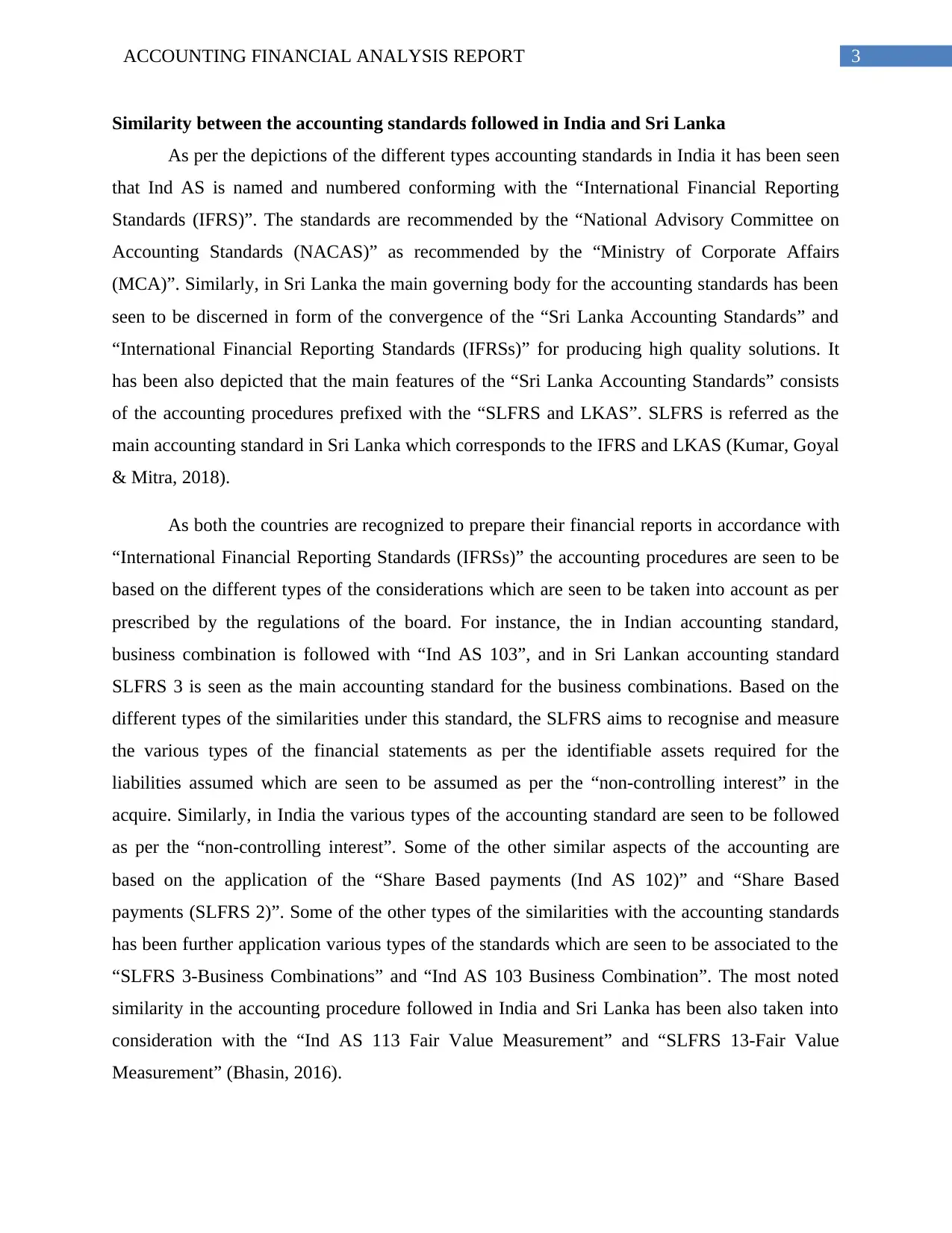
3ACCOUNTING FINANCIAL ANALYSIS REPORT
Similarity between the accounting standards followed in India and Sri Lanka
As per the depictions of the different types accounting standards in India it has been seen
that Ind AS is named and numbered conforming with the “International Financial Reporting
Standards (IFRS)”. The standards are recommended by the “National Advisory Committee on
Accounting Standards (NACAS)” as recommended by the “Ministry of Corporate Affairs
(MCA)”. Similarly, in Sri Lanka the main governing body for the accounting standards has been
seen to be discerned in form of the convergence of the “Sri Lanka Accounting Standards” and
“International Financial Reporting Standards (IFRSs)” for producing high quality solutions. It
has been also depicted that the main features of the “Sri Lanka Accounting Standards” consists
of the accounting procedures prefixed with the “SLFRS and LKAS”. SLFRS is referred as the
main accounting standard in Sri Lanka which corresponds to the IFRS and LKAS (Kumar, Goyal
& Mitra, 2018).
As both the countries are recognized to prepare their financial reports in accordance with
“International Financial Reporting Standards (IFRSs)” the accounting procedures are seen to be
based on the different types of the considerations which are seen to be taken into account as per
prescribed by the regulations of the board. For instance, the in Indian accounting standard,
business combination is followed with “Ind AS 103”, and in Sri Lankan accounting standard
SLFRS 3 is seen as the main accounting standard for the business combinations. Based on the
different types of the similarities under this standard, the SLFRS aims to recognise and measure
the various types of the financial statements as per the identifiable assets required for the
liabilities assumed which are seen to be assumed as per the “non-controlling interest” in the
acquire. Similarly, in India the various types of the accounting standard are seen to be followed
as per the “non-controlling interest”. Some of the other similar aspects of the accounting are
based on the application of the “Share Based payments (Ind AS 102)” and “Share Based
payments (SLFRS 2)”. Some of the other types of the similarities with the accounting standards
has been further application various types of the standards which are seen to be associated to the
“SLFRS 3-Business Combinations” and “Ind AS 103 Business Combination”. The most noted
similarity in the accounting procedure followed in India and Sri Lanka has been also taken into
consideration with the “Ind AS 113 Fair Value Measurement” and “SLFRS 13-Fair Value
Measurement” (Bhasin, 2016).
Similarity between the accounting standards followed in India and Sri Lanka
As per the depictions of the different types accounting standards in India it has been seen
that Ind AS is named and numbered conforming with the “International Financial Reporting
Standards (IFRS)”. The standards are recommended by the “National Advisory Committee on
Accounting Standards (NACAS)” as recommended by the “Ministry of Corporate Affairs
(MCA)”. Similarly, in Sri Lanka the main governing body for the accounting standards has been
seen to be discerned in form of the convergence of the “Sri Lanka Accounting Standards” and
“International Financial Reporting Standards (IFRSs)” for producing high quality solutions. It
has been also depicted that the main features of the “Sri Lanka Accounting Standards” consists
of the accounting procedures prefixed with the “SLFRS and LKAS”. SLFRS is referred as the
main accounting standard in Sri Lanka which corresponds to the IFRS and LKAS (Kumar, Goyal
& Mitra, 2018).
As both the countries are recognized to prepare their financial reports in accordance with
“International Financial Reporting Standards (IFRSs)” the accounting procedures are seen to be
based on the different types of the considerations which are seen to be taken into account as per
prescribed by the regulations of the board. For instance, the in Indian accounting standard,
business combination is followed with “Ind AS 103”, and in Sri Lankan accounting standard
SLFRS 3 is seen as the main accounting standard for the business combinations. Based on the
different types of the similarities under this standard, the SLFRS aims to recognise and measure
the various types of the financial statements as per the identifiable assets required for the
liabilities assumed which are seen to be assumed as per the “non-controlling interest” in the
acquire. Similarly, in India the various types of the accounting standard are seen to be followed
as per the “non-controlling interest”. Some of the other similar aspects of the accounting are
based on the application of the “Share Based payments (Ind AS 102)” and “Share Based
payments (SLFRS 2)”. Some of the other types of the similarities with the accounting standards
has been further application various types of the standards which are seen to be associated to the
“SLFRS 3-Business Combinations” and “Ind AS 103 Business Combination”. The most noted
similarity in the accounting procedure followed in India and Sri Lanka has been also taken into
consideration with the “Ind AS 113 Fair Value Measurement” and “SLFRS 13-Fair Value
Measurement” (Bhasin, 2016).
Paraphrase This Document
Need a fresh take? Get an instant paraphrase of this document with our AI Paraphraser
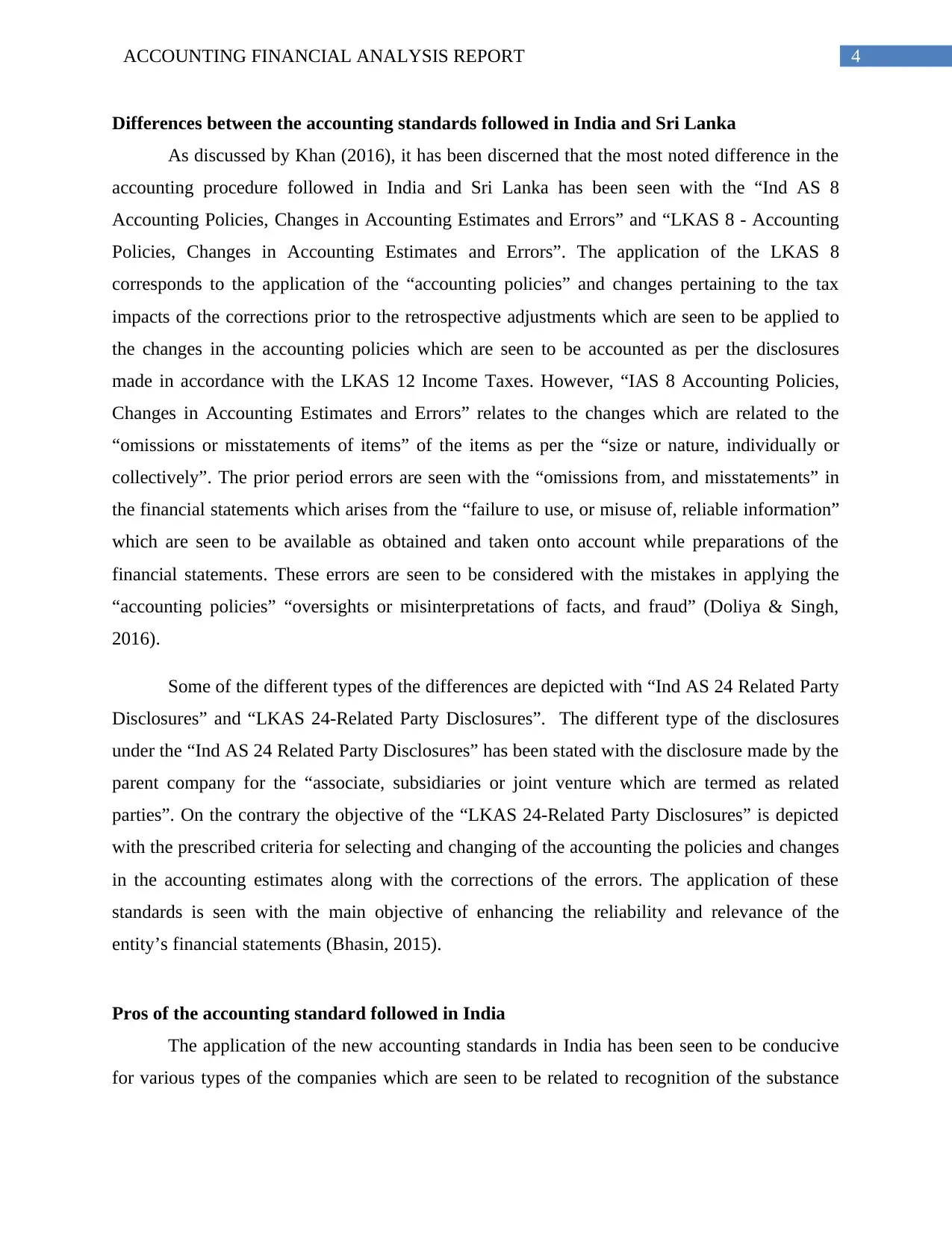
4ACCOUNTING FINANCIAL ANALYSIS REPORT
Differences between the accounting standards followed in India and Sri Lanka
As discussed by Khan (2016), it has been discerned that the most noted difference in the
accounting procedure followed in India and Sri Lanka has been seen with the “Ind AS 8
Accounting Policies, Changes in Accounting Estimates and Errors” and “LKAS 8 - Accounting
Policies, Changes in Accounting Estimates and Errors”. The application of the LKAS 8
corresponds to the application of the “accounting policies” and changes pertaining to the tax
impacts of the corrections prior to the retrospective adjustments which are seen to be applied to
the changes in the accounting policies which are seen to be accounted as per the disclosures
made in accordance with the LKAS 12 Income Taxes. However, “IAS 8 Accounting Policies,
Changes in Accounting Estimates and Errors” relates to the changes which are related to the
“omissions or misstatements of items” of the items as per the “size or nature, individually or
collectively”. The prior period errors are seen with the “omissions from, and misstatements” in
the financial statements which arises from the “failure to use, or misuse of, reliable information”
which are seen to be available as obtained and taken onto account while preparations of the
financial statements. These errors are seen to be considered with the mistakes in applying the
“accounting policies” “oversights or misinterpretations of facts, and fraud” (Doliya & Singh,
2016).
Some of the different types of the differences are depicted with “Ind AS 24 Related Party
Disclosures” and “LKAS 24-Related Party Disclosures”. The different type of the disclosures
under the “Ind AS 24 Related Party Disclosures” has been stated with the disclosure made by the
parent company for the “associate, subsidiaries or joint venture which are termed as related
parties”. On the contrary the objective of the “LKAS 24-Related Party Disclosures” is depicted
with the prescribed criteria for selecting and changing of the accounting the policies and changes
in the accounting estimates along with the corrections of the errors. The application of these
standards is seen with the main objective of enhancing the reliability and relevance of the
entity’s financial statements (Bhasin, 2015).
Pros of the accounting standard followed in India
The application of the new accounting standards in India has been seen to be conducive
for various types of the companies which are seen to be related to recognition of the substance
Differences between the accounting standards followed in India and Sri Lanka
As discussed by Khan (2016), it has been discerned that the most noted difference in the
accounting procedure followed in India and Sri Lanka has been seen with the “Ind AS 8
Accounting Policies, Changes in Accounting Estimates and Errors” and “LKAS 8 - Accounting
Policies, Changes in Accounting Estimates and Errors”. The application of the LKAS 8
corresponds to the application of the “accounting policies” and changes pertaining to the tax
impacts of the corrections prior to the retrospective adjustments which are seen to be applied to
the changes in the accounting policies which are seen to be accounted as per the disclosures
made in accordance with the LKAS 12 Income Taxes. However, “IAS 8 Accounting Policies,
Changes in Accounting Estimates and Errors” relates to the changes which are related to the
“omissions or misstatements of items” of the items as per the “size or nature, individually or
collectively”. The prior period errors are seen with the “omissions from, and misstatements” in
the financial statements which arises from the “failure to use, or misuse of, reliable information”
which are seen to be available as obtained and taken onto account while preparations of the
financial statements. These errors are seen to be considered with the mistakes in applying the
“accounting policies” “oversights or misinterpretations of facts, and fraud” (Doliya & Singh,
2016).
Some of the different types of the differences are depicted with “Ind AS 24 Related Party
Disclosures” and “LKAS 24-Related Party Disclosures”. The different type of the disclosures
under the “Ind AS 24 Related Party Disclosures” has been stated with the disclosure made by the
parent company for the “associate, subsidiaries or joint venture which are termed as related
parties”. On the contrary the objective of the “LKAS 24-Related Party Disclosures” is depicted
with the prescribed criteria for selecting and changing of the accounting the policies and changes
in the accounting estimates along with the corrections of the errors. The application of these
standards is seen with the main objective of enhancing the reliability and relevance of the
entity’s financial statements (Bhasin, 2015).
Pros of the accounting standard followed in India
The application of the new accounting standards in India has been seen to be conducive
for various types of the companies which are seen to be related to recognition of the substance
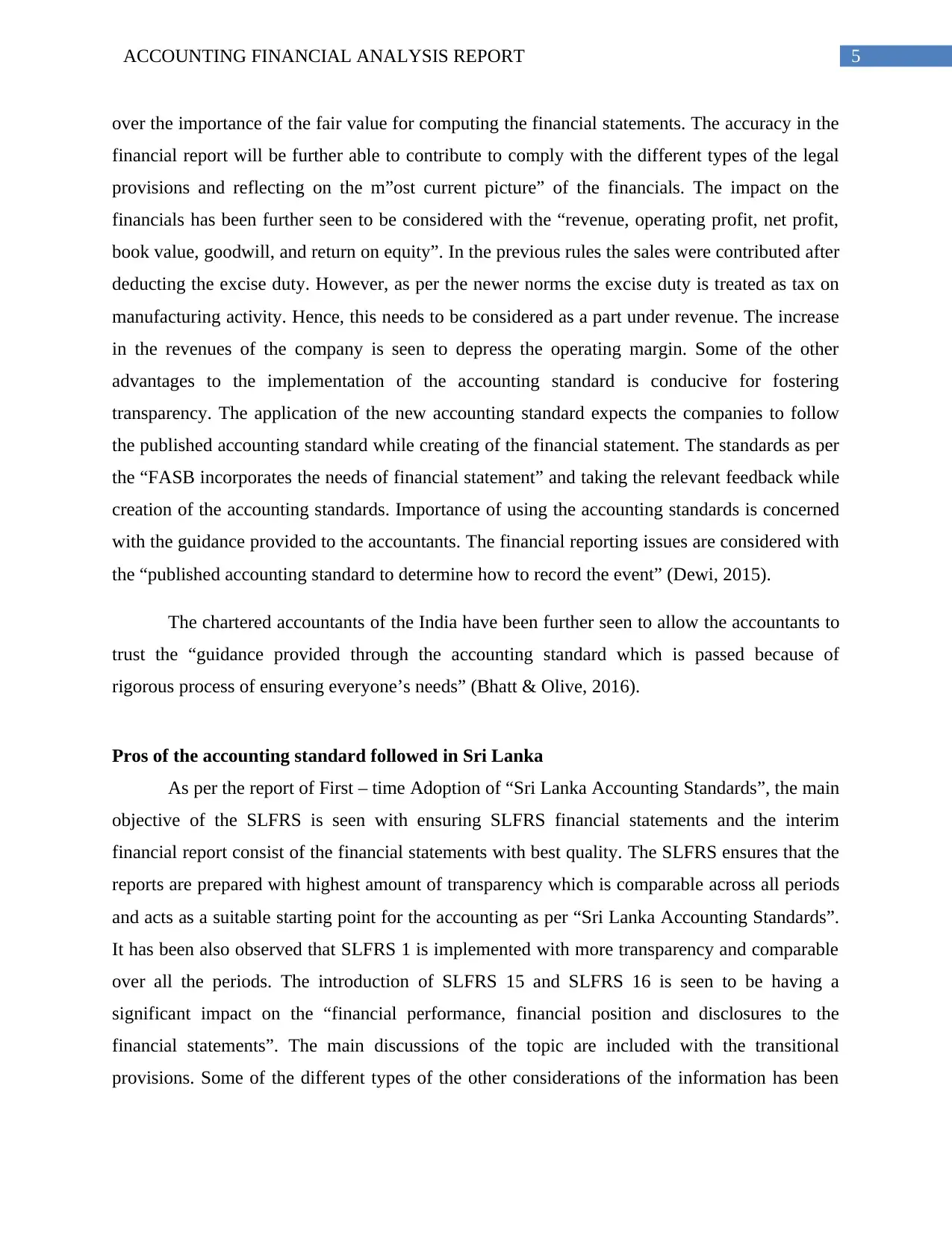
5ACCOUNTING FINANCIAL ANALYSIS REPORT
over the importance of the fair value for computing the financial statements. The accuracy in the
financial report will be further able to contribute to comply with the different types of the legal
provisions and reflecting on the m”ost current picture” of the financials. The impact on the
financials has been further seen to be considered with the “revenue, operating profit, net profit,
book value, goodwill, and return on equity”. In the previous rules the sales were contributed after
deducting the excise duty. However, as per the newer norms the excise duty is treated as tax on
manufacturing activity. Hence, this needs to be considered as a part under revenue. The increase
in the revenues of the company is seen to depress the operating margin. Some of the other
advantages to the implementation of the accounting standard is conducive for fostering
transparency. The application of the new accounting standard expects the companies to follow
the published accounting standard while creating of the financial statement. The standards as per
the “FASB incorporates the needs of financial statement” and taking the relevant feedback while
creation of the accounting standards. Importance of using the accounting standards is concerned
with the guidance provided to the accountants. The financial reporting issues are considered with
the “published accounting standard to determine how to record the event” (Dewi, 2015).
The chartered accountants of the India have been further seen to allow the accountants to
trust the “guidance provided through the accounting standard which is passed because of
rigorous process of ensuring everyone’s needs” (Bhatt & Olive, 2016).
Pros of the accounting standard followed in Sri Lanka
As per the report of First – time Adoption of “Sri Lanka Accounting Standards”, the main
objective of the SLFRS is seen with ensuring SLFRS financial statements and the interim
financial report consist of the financial statements with best quality. The SLFRS ensures that the
reports are prepared with highest amount of transparency which is comparable across all periods
and acts as a suitable starting point for the accounting as per “Sri Lanka Accounting Standards”.
It has been also observed that SLFRS 1 is implemented with more transparency and comparable
over all the periods. The introduction of SLFRS 15 and SLFRS 16 is seen to be having a
significant impact on the “financial performance, financial position and disclosures to the
financial statements”. The main discussions of the topic are included with the transitional
provisions. Some of the different types of the other considerations of the information has been
over the importance of the fair value for computing the financial statements. The accuracy in the
financial report will be further able to contribute to comply with the different types of the legal
provisions and reflecting on the m”ost current picture” of the financials. The impact on the
financials has been further seen to be considered with the “revenue, operating profit, net profit,
book value, goodwill, and return on equity”. In the previous rules the sales were contributed after
deducting the excise duty. However, as per the newer norms the excise duty is treated as tax on
manufacturing activity. Hence, this needs to be considered as a part under revenue. The increase
in the revenues of the company is seen to depress the operating margin. Some of the other
advantages to the implementation of the accounting standard is conducive for fostering
transparency. The application of the new accounting standard expects the companies to follow
the published accounting standard while creating of the financial statement. The standards as per
the “FASB incorporates the needs of financial statement” and taking the relevant feedback while
creation of the accounting standards. Importance of using the accounting standards is concerned
with the guidance provided to the accountants. The financial reporting issues are considered with
the “published accounting standard to determine how to record the event” (Dewi, 2015).
The chartered accountants of the India have been further seen to allow the accountants to
trust the “guidance provided through the accounting standard which is passed because of
rigorous process of ensuring everyone’s needs” (Bhatt & Olive, 2016).
Pros of the accounting standard followed in Sri Lanka
As per the report of First – time Adoption of “Sri Lanka Accounting Standards”, the main
objective of the SLFRS is seen with ensuring SLFRS financial statements and the interim
financial report consist of the financial statements with best quality. The SLFRS ensures that the
reports are prepared with highest amount of transparency which is comparable across all periods
and acts as a suitable starting point for the accounting as per “Sri Lanka Accounting Standards”.
It has been also observed that SLFRS 1 is implemented with more transparency and comparable
over all the periods. The introduction of SLFRS 15 and SLFRS 16 is seen to be having a
significant impact on the “financial performance, financial position and disclosures to the
financial statements”. The main discussions of the topic are included with the transitional
provisions. Some of the different types of the other considerations of the information has been
⊘ This is a preview!⊘
Do you want full access?
Subscribe today to unlock all pages.

Trusted by 1+ million students worldwide
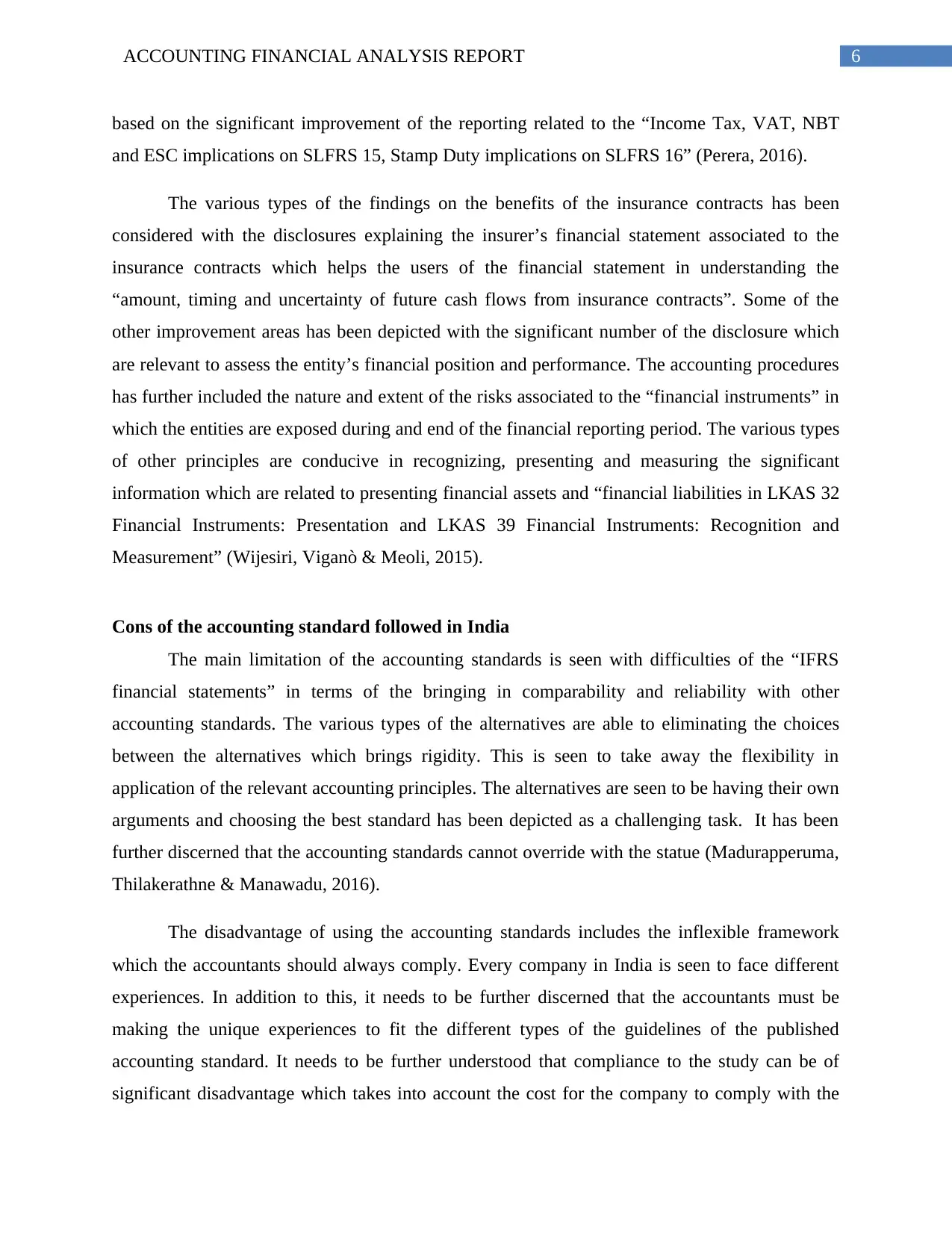
6ACCOUNTING FINANCIAL ANALYSIS REPORT
based on the significant improvement of the reporting related to the “Income Tax, VAT, NBT
and ESC implications on SLFRS 15, Stamp Duty implications on SLFRS 16” (Perera, 2016).
The various types of the findings on the benefits of the insurance contracts has been
considered with the disclosures explaining the insurer’s financial statement associated to the
insurance contracts which helps the users of the financial statement in understanding the
“amount, timing and uncertainty of future cash flows from insurance contracts”. Some of the
other improvement areas has been depicted with the significant number of the disclosure which
are relevant to assess the entity’s financial position and performance. The accounting procedures
has further included the nature and extent of the risks associated to the “financial instruments” in
which the entities are exposed during and end of the financial reporting period. The various types
of other principles are conducive in recognizing, presenting and measuring the significant
information which are related to presenting financial assets and “financial liabilities in LKAS 32
Financial Instruments: Presentation and LKAS 39 Financial Instruments: Recognition and
Measurement” (Wijesiri, Viganò & Meoli, 2015).
Cons of the accounting standard followed in India
The main limitation of the accounting standards is seen with difficulties of the “IFRS
financial statements” in terms of the bringing in comparability and reliability with other
accounting standards. The various types of the alternatives are able to eliminating the choices
between the alternatives which brings rigidity. This is seen to take away the flexibility in
application of the relevant accounting principles. The alternatives are seen to be having their own
arguments and choosing the best standard has been depicted as a challenging task. It has been
further discerned that the accounting standards cannot override with the statue (Madurapperuma,
Thilakerathne & Manawadu, 2016).
The disadvantage of using the accounting standards includes the inflexible framework
which the accountants should always comply. Every company in India is seen to face different
experiences. In addition to this, it needs to be further discerned that the accountants must be
making the unique experiences to fit the different types of the guidelines of the published
accounting standard. It needs to be further understood that compliance to the study can be of
significant disadvantage which takes into account the cost for the company to comply with the
based on the significant improvement of the reporting related to the “Income Tax, VAT, NBT
and ESC implications on SLFRS 15, Stamp Duty implications on SLFRS 16” (Perera, 2016).
The various types of the findings on the benefits of the insurance contracts has been
considered with the disclosures explaining the insurer’s financial statement associated to the
insurance contracts which helps the users of the financial statement in understanding the
“amount, timing and uncertainty of future cash flows from insurance contracts”. Some of the
other improvement areas has been depicted with the significant number of the disclosure which
are relevant to assess the entity’s financial position and performance. The accounting procedures
has further included the nature and extent of the risks associated to the “financial instruments” in
which the entities are exposed during and end of the financial reporting period. The various types
of other principles are conducive in recognizing, presenting and measuring the significant
information which are related to presenting financial assets and “financial liabilities in LKAS 32
Financial Instruments: Presentation and LKAS 39 Financial Instruments: Recognition and
Measurement” (Wijesiri, Viganò & Meoli, 2015).
Cons of the accounting standard followed in India
The main limitation of the accounting standards is seen with difficulties of the “IFRS
financial statements” in terms of the bringing in comparability and reliability with other
accounting standards. The various types of the alternatives are able to eliminating the choices
between the alternatives which brings rigidity. This is seen to take away the flexibility in
application of the relevant accounting principles. The alternatives are seen to be having their own
arguments and choosing the best standard has been depicted as a challenging task. It has been
further discerned that the accounting standards cannot override with the statue (Madurapperuma,
Thilakerathne & Manawadu, 2016).
The disadvantage of using the accounting standards includes the inflexible framework
which the accountants should always comply. Every company in India is seen to face different
experiences. In addition to this, it needs to be further discerned that the accountants must be
making the unique experiences to fit the different types of the guidelines of the published
accounting standard. It needs to be further understood that compliance to the study can be of
significant disadvantage which takes into account the cost for the company to comply with the
Paraphrase This Document
Need a fresh take? Get an instant paraphrase of this document with our AI Paraphraser
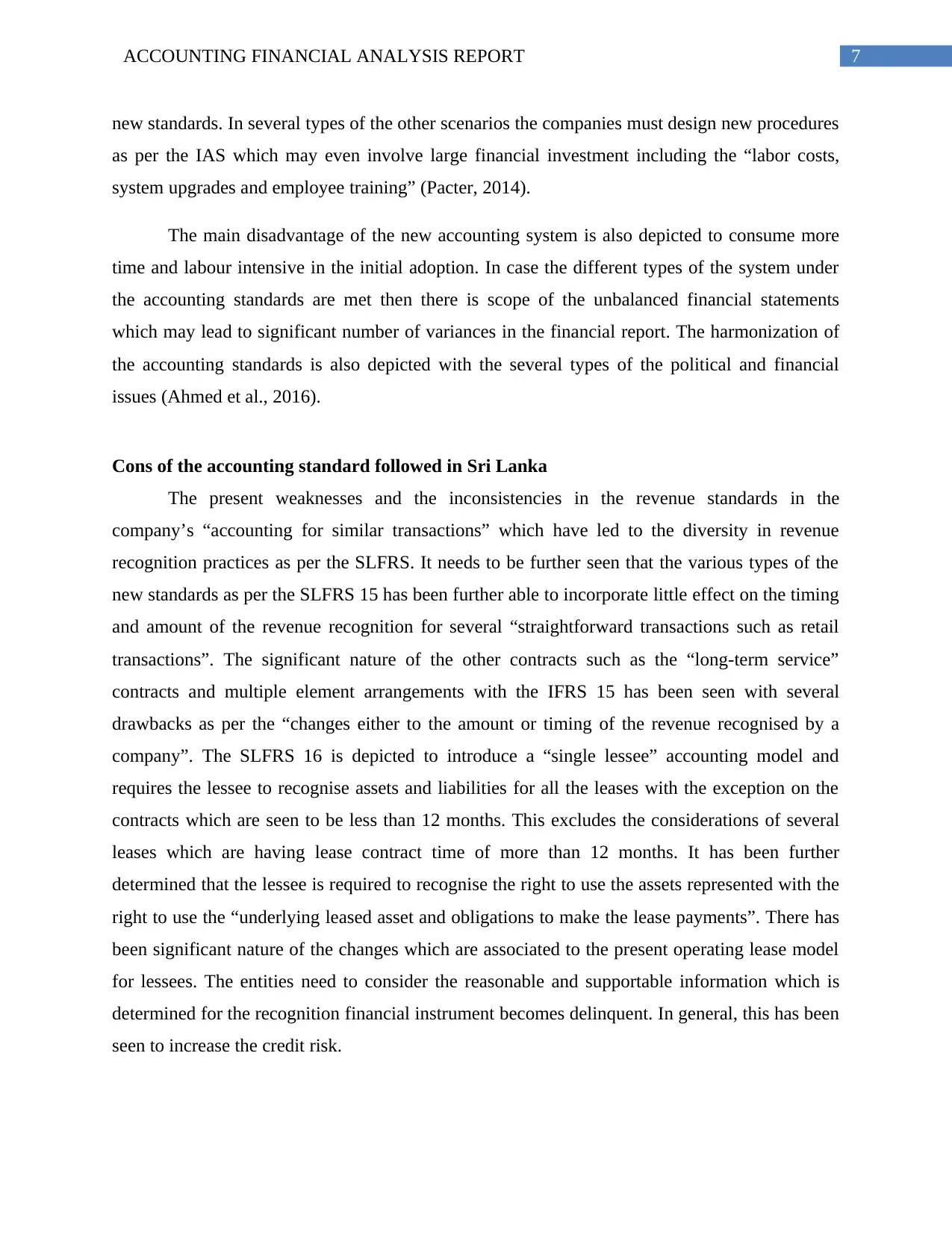
7ACCOUNTING FINANCIAL ANALYSIS REPORT
new standards. In several types of the other scenarios the companies must design new procedures
as per the IAS which may even involve large financial investment including the “labor costs,
system upgrades and employee training” (Pacter, 2014).
The main disadvantage of the new accounting system is also depicted to consume more
time and labour intensive in the initial adoption. In case the different types of the system under
the accounting standards are met then there is scope of the unbalanced financial statements
which may lead to significant number of variances in the financial report. The harmonization of
the accounting standards is also depicted with the several types of the political and financial
issues (Ahmed et al., 2016).
Cons of the accounting standard followed in Sri Lanka
The present weaknesses and the inconsistencies in the revenue standards in the
company’s “accounting for similar transactions” which have led to the diversity in revenue
recognition practices as per the SLFRS. It needs to be further seen that the various types of the
new standards as per the SLFRS 15 has been further able to incorporate little effect on the timing
and amount of the revenue recognition for several “straightforward transactions such as retail
transactions”. The significant nature of the other contracts such as the “long-term service”
contracts and multiple element arrangements with the IFRS 15 has been seen with several
drawbacks as per the “changes either to the amount or timing of the revenue recognised by a
company”. The SLFRS 16 is depicted to introduce a “single lessee” accounting model and
requires the lessee to recognise assets and liabilities for all the leases with the exception on the
contracts which are seen to be less than 12 months. This excludes the considerations of several
leases which are having lease contract time of more than 12 months. It has been further
determined that the lessee is required to recognise the right to use the assets represented with the
right to use the “underlying leased asset and obligations to make the lease payments”. There has
been significant nature of the changes which are associated to the present operating lease model
for lessees. The entities need to consider the reasonable and supportable information which is
determined for the recognition financial instrument becomes delinquent. In general, this has been
seen to increase the credit risk.
new standards. In several types of the other scenarios the companies must design new procedures
as per the IAS which may even involve large financial investment including the “labor costs,
system upgrades and employee training” (Pacter, 2014).
The main disadvantage of the new accounting system is also depicted to consume more
time and labour intensive in the initial adoption. In case the different types of the system under
the accounting standards are met then there is scope of the unbalanced financial statements
which may lead to significant number of variances in the financial report. The harmonization of
the accounting standards is also depicted with the several types of the political and financial
issues (Ahmed et al., 2016).
Cons of the accounting standard followed in Sri Lanka
The present weaknesses and the inconsistencies in the revenue standards in the
company’s “accounting for similar transactions” which have led to the diversity in revenue
recognition practices as per the SLFRS. It needs to be further seen that the various types of the
new standards as per the SLFRS 15 has been further able to incorporate little effect on the timing
and amount of the revenue recognition for several “straightforward transactions such as retail
transactions”. The significant nature of the other contracts such as the “long-term service”
contracts and multiple element arrangements with the IFRS 15 has been seen with several
drawbacks as per the “changes either to the amount or timing of the revenue recognised by a
company”. The SLFRS 16 is depicted to introduce a “single lessee” accounting model and
requires the lessee to recognise assets and liabilities for all the leases with the exception on the
contracts which are seen to be less than 12 months. This excludes the considerations of several
leases which are having lease contract time of more than 12 months. It has been further
determined that the lessee is required to recognise the right to use the assets represented with the
right to use the “underlying leased asset and obligations to make the lease payments”. There has
been significant nature of the changes which are associated to the present operating lease model
for lessees. The entities need to consider the reasonable and supportable information which is
determined for the recognition financial instrument becomes delinquent. In general, this has been
seen to increase the credit risk.
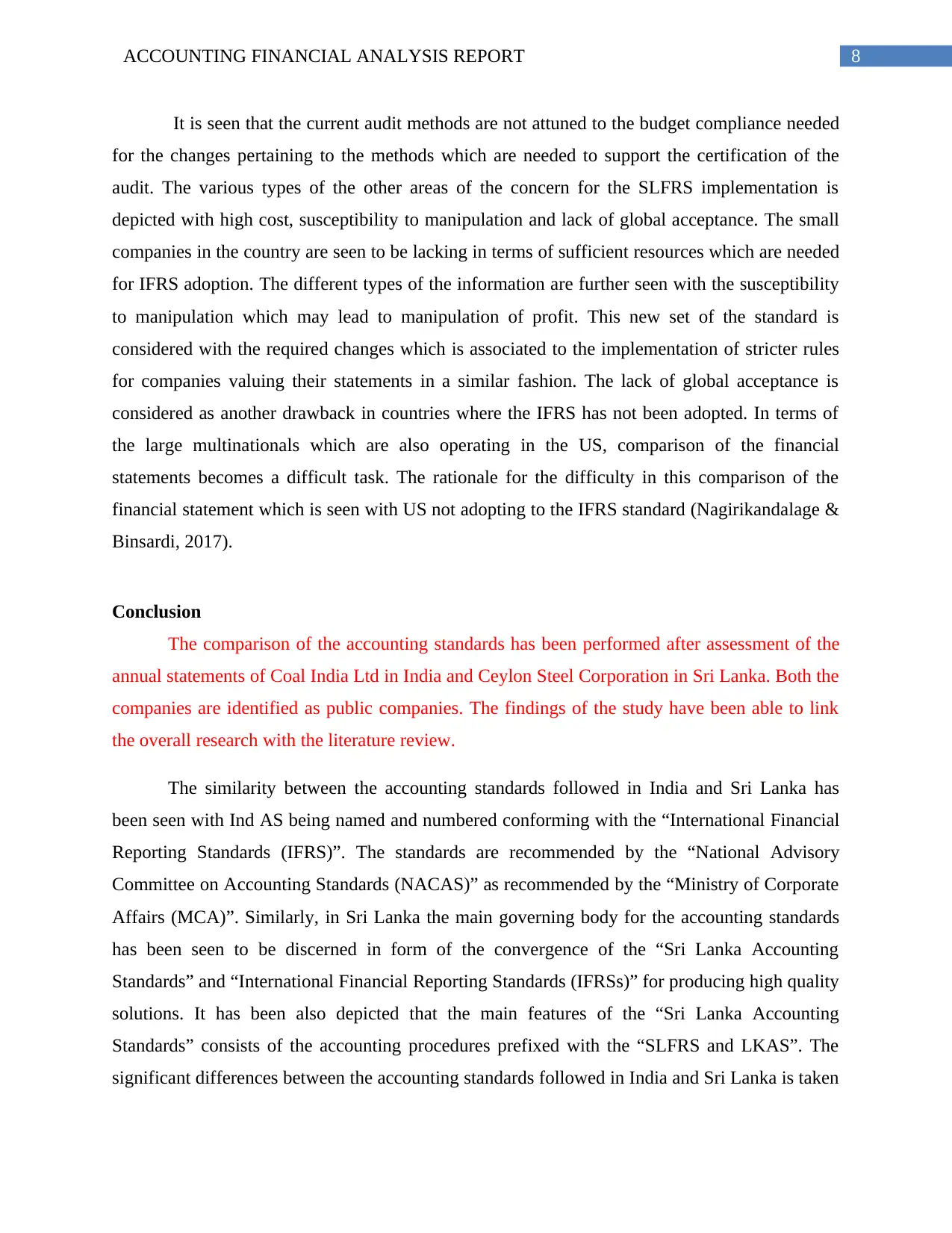
8ACCOUNTING FINANCIAL ANALYSIS REPORT
It is seen that the current audit methods are not attuned to the budget compliance needed
for the changes pertaining to the methods which are needed to support the certification of the
audit. The various types of the other areas of the concern for the SLFRS implementation is
depicted with high cost, susceptibility to manipulation and lack of global acceptance. The small
companies in the country are seen to be lacking in terms of sufficient resources which are needed
for IFRS adoption. The different types of the information are further seen with the susceptibility
to manipulation which may lead to manipulation of profit. This new set of the standard is
considered with the required changes which is associated to the implementation of stricter rules
for companies valuing their statements in a similar fashion. The lack of global acceptance is
considered as another drawback in countries where the IFRS has not been adopted. In terms of
the large multinationals which are also operating in the US, comparison of the financial
statements becomes a difficult task. The rationale for the difficulty in this comparison of the
financial statement which is seen with US not adopting to the IFRS standard (Nagirikandalage &
Binsardi, 2017).
Conclusion
The comparison of the accounting standards has been performed after assessment of the
annual statements of Coal India Ltd in India and Ceylon Steel Corporation in Sri Lanka. Both the
companies are identified as public companies. The findings of the study have been able to link
the overall research with the literature review.
The similarity between the accounting standards followed in India and Sri Lanka has
been seen with Ind AS being named and numbered conforming with the “International Financial
Reporting Standards (IFRS)”. The standards are recommended by the “National Advisory
Committee on Accounting Standards (NACAS)” as recommended by the “Ministry of Corporate
Affairs (MCA)”. Similarly, in Sri Lanka the main governing body for the accounting standards
has been seen to be discerned in form of the convergence of the “Sri Lanka Accounting
Standards” and “International Financial Reporting Standards (IFRSs)” for producing high quality
solutions. It has been also depicted that the main features of the “Sri Lanka Accounting
Standards” consists of the accounting procedures prefixed with the “SLFRS and LKAS”. The
significant differences between the accounting standards followed in India and Sri Lanka is taken
It is seen that the current audit methods are not attuned to the budget compliance needed
for the changes pertaining to the methods which are needed to support the certification of the
audit. The various types of the other areas of the concern for the SLFRS implementation is
depicted with high cost, susceptibility to manipulation and lack of global acceptance. The small
companies in the country are seen to be lacking in terms of sufficient resources which are needed
for IFRS adoption. The different types of the information are further seen with the susceptibility
to manipulation which may lead to manipulation of profit. This new set of the standard is
considered with the required changes which is associated to the implementation of stricter rules
for companies valuing their statements in a similar fashion. The lack of global acceptance is
considered as another drawback in countries where the IFRS has not been adopted. In terms of
the large multinationals which are also operating in the US, comparison of the financial
statements becomes a difficult task. The rationale for the difficulty in this comparison of the
financial statement which is seen with US not adopting to the IFRS standard (Nagirikandalage &
Binsardi, 2017).
Conclusion
The comparison of the accounting standards has been performed after assessment of the
annual statements of Coal India Ltd in India and Ceylon Steel Corporation in Sri Lanka. Both the
companies are identified as public companies. The findings of the study have been able to link
the overall research with the literature review.
The similarity between the accounting standards followed in India and Sri Lanka has
been seen with Ind AS being named and numbered conforming with the “International Financial
Reporting Standards (IFRS)”. The standards are recommended by the “National Advisory
Committee on Accounting Standards (NACAS)” as recommended by the “Ministry of Corporate
Affairs (MCA)”. Similarly, in Sri Lanka the main governing body for the accounting standards
has been seen to be discerned in form of the convergence of the “Sri Lanka Accounting
Standards” and “International Financial Reporting Standards (IFRSs)” for producing high quality
solutions. It has been also depicted that the main features of the “Sri Lanka Accounting
Standards” consists of the accounting procedures prefixed with the “SLFRS and LKAS”. The
significant differences between the accounting standards followed in India and Sri Lanka is taken
⊘ This is a preview!⊘
Do you want full access?
Subscribe today to unlock all pages.

Trusted by 1+ million students worldwide
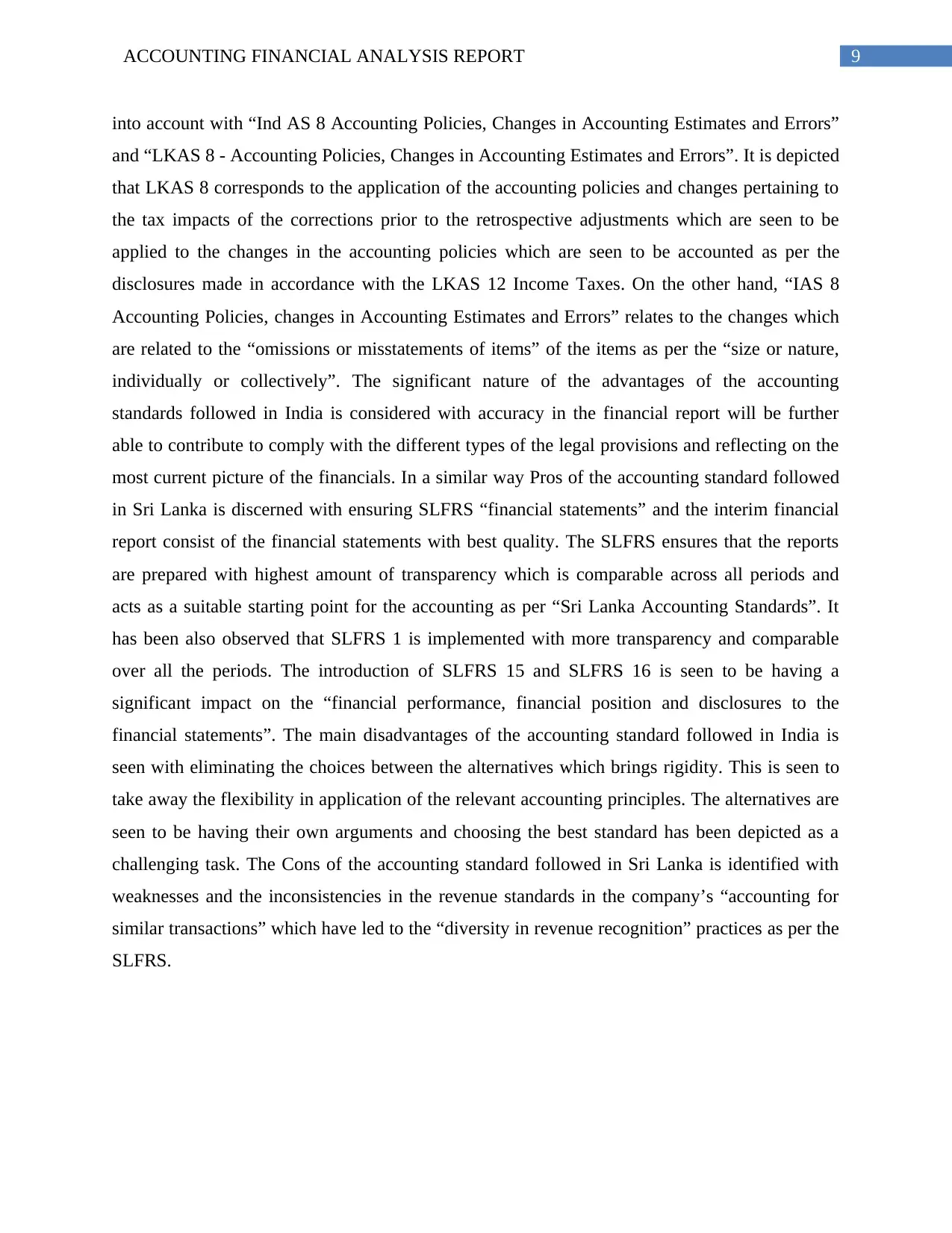
9ACCOUNTING FINANCIAL ANALYSIS REPORT
into account with “Ind AS 8 Accounting Policies, Changes in Accounting Estimates and Errors”
and “LKAS 8 - Accounting Policies, Changes in Accounting Estimates and Errors”. It is depicted
that LKAS 8 corresponds to the application of the accounting policies and changes pertaining to
the tax impacts of the corrections prior to the retrospective adjustments which are seen to be
applied to the changes in the accounting policies which are seen to be accounted as per the
disclosures made in accordance with the LKAS 12 Income Taxes. On the other hand, “IAS 8
Accounting Policies, changes in Accounting Estimates and Errors” relates to the changes which
are related to the “omissions or misstatements of items” of the items as per the “size or nature,
individually or collectively”. The significant nature of the advantages of the accounting
standards followed in India is considered with accuracy in the financial report will be further
able to contribute to comply with the different types of the legal provisions and reflecting on the
most current picture of the financials. In a similar way Pros of the accounting standard followed
in Sri Lanka is discerned with ensuring SLFRS “financial statements” and the interim financial
report consist of the financial statements with best quality. The SLFRS ensures that the reports
are prepared with highest amount of transparency which is comparable across all periods and
acts as a suitable starting point for the accounting as per “Sri Lanka Accounting Standards”. It
has been also observed that SLFRS 1 is implemented with more transparency and comparable
over all the periods. The introduction of SLFRS 15 and SLFRS 16 is seen to be having a
significant impact on the “financial performance, financial position and disclosures to the
financial statements”. The main disadvantages of the accounting standard followed in India is
seen with eliminating the choices between the alternatives which brings rigidity. This is seen to
take away the flexibility in application of the relevant accounting principles. The alternatives are
seen to be having their own arguments and choosing the best standard has been depicted as a
challenging task. The Cons of the accounting standard followed in Sri Lanka is identified with
weaknesses and the inconsistencies in the revenue standards in the company’s “accounting for
similar transactions” which have led to the “diversity in revenue recognition” practices as per the
SLFRS.
into account with “Ind AS 8 Accounting Policies, Changes in Accounting Estimates and Errors”
and “LKAS 8 - Accounting Policies, Changes in Accounting Estimates and Errors”. It is depicted
that LKAS 8 corresponds to the application of the accounting policies and changes pertaining to
the tax impacts of the corrections prior to the retrospective adjustments which are seen to be
applied to the changes in the accounting policies which are seen to be accounted as per the
disclosures made in accordance with the LKAS 12 Income Taxes. On the other hand, “IAS 8
Accounting Policies, changes in Accounting Estimates and Errors” relates to the changes which
are related to the “omissions or misstatements of items” of the items as per the “size or nature,
individually or collectively”. The significant nature of the advantages of the accounting
standards followed in India is considered with accuracy in the financial report will be further
able to contribute to comply with the different types of the legal provisions and reflecting on the
most current picture of the financials. In a similar way Pros of the accounting standard followed
in Sri Lanka is discerned with ensuring SLFRS “financial statements” and the interim financial
report consist of the financial statements with best quality. The SLFRS ensures that the reports
are prepared with highest amount of transparency which is comparable across all periods and
acts as a suitable starting point for the accounting as per “Sri Lanka Accounting Standards”. It
has been also observed that SLFRS 1 is implemented with more transparency and comparable
over all the periods. The introduction of SLFRS 15 and SLFRS 16 is seen to be having a
significant impact on the “financial performance, financial position and disclosures to the
financial statements”. The main disadvantages of the accounting standard followed in India is
seen with eliminating the choices between the alternatives which brings rigidity. This is seen to
take away the flexibility in application of the relevant accounting principles. The alternatives are
seen to be having their own arguments and choosing the best standard has been depicted as a
challenging task. The Cons of the accounting standard followed in Sri Lanka is identified with
weaknesses and the inconsistencies in the revenue standards in the company’s “accounting for
similar transactions” which have led to the “diversity in revenue recognition” practices as per the
SLFRS.
Paraphrase This Document
Need a fresh take? Get an instant paraphrase of this document with our AI Paraphraser
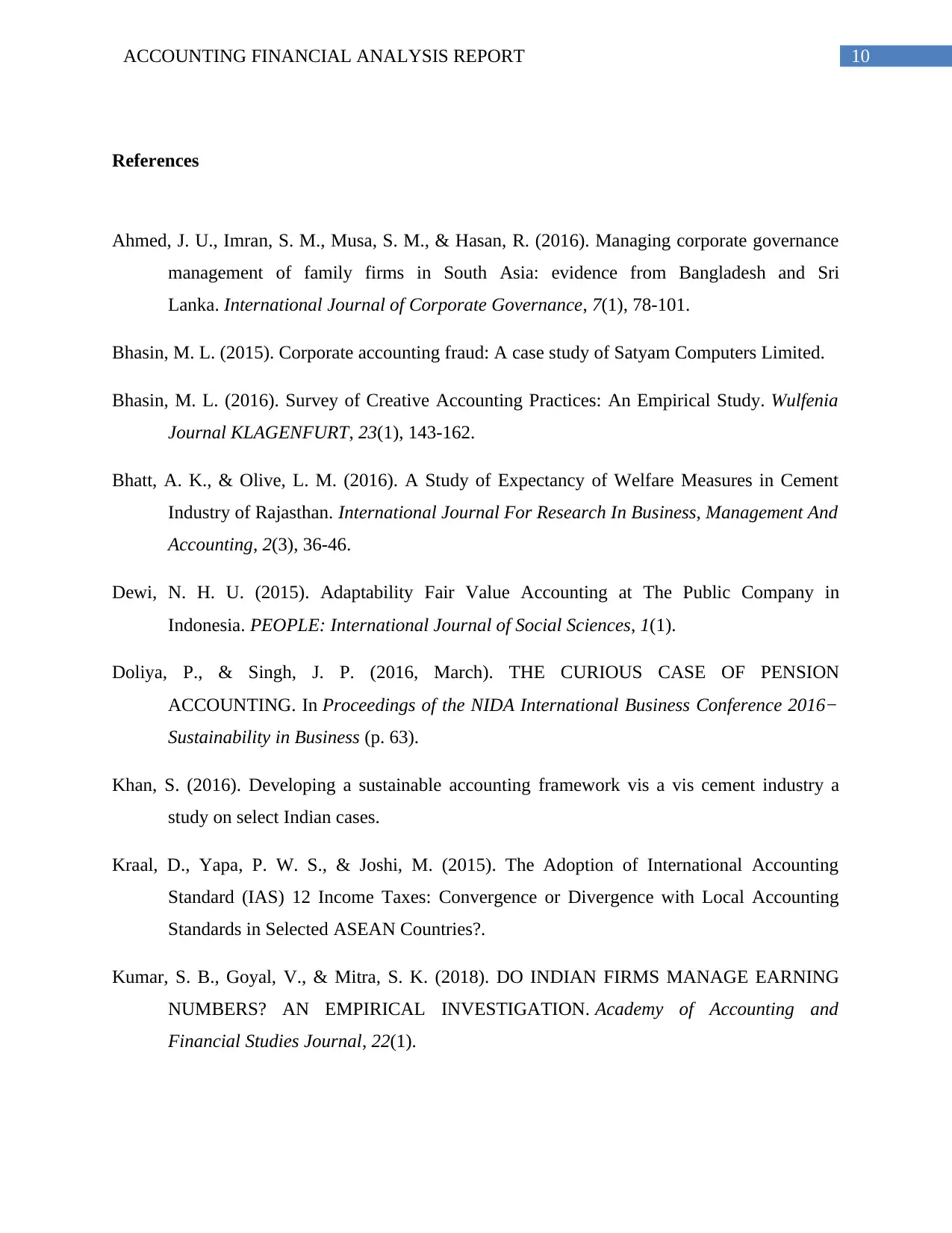
10ACCOUNTING FINANCIAL ANALYSIS REPORT
References
Ahmed, J. U., Imran, S. M., Musa, S. M., & Hasan, R. (2016). Managing corporate governance
management of family firms in South Asia: evidence from Bangladesh and Sri
Lanka. International Journal of Corporate Governance, 7(1), 78-101.
Bhasin, M. L. (2015). Corporate accounting fraud: A case study of Satyam Computers Limited.
Bhasin, M. L. (2016). Survey of Creative Accounting Practices: An Empirical Study. Wulfenia
Journal KLAGENFURT, 23(1), 143-162.
Bhatt, A. K., & Olive, L. M. (2016). A Study of Expectancy of Welfare Measures in Cement
Industry of Rajasthan. International Journal For Research In Business, Management And
Accounting, 2(3), 36-46.
Dewi, N. H. U. (2015). Adaptability Fair Value Accounting at The Public Company in
Indonesia. PEOPLE: International Journal of Social Sciences, 1(1).
Doliya, P., & Singh, J. P. (2016, March). THE CURIOUS CASE OF PENSION
ACCOUNTING. In Proceedings of the NIDA International Business Conference 2016−
Sustainability in Business (p. 63).
Khan, S. (2016). Developing a sustainable accounting framework vis a vis cement industry a
study on select Indian cases.
Kraal, D., Yapa, P. W. S., & Joshi, M. (2015). The Adoption of International Accounting
Standard (IAS) 12 Income Taxes: Convergence or Divergence with Local Accounting
Standards in Selected ASEAN Countries?.
Kumar, S. B., Goyal, V., & Mitra, S. K. (2018). DO INDIAN FIRMS MANAGE EARNING
NUMBERS? AN EMPIRICAL INVESTIGATION. Academy of Accounting and
Financial Studies Journal, 22(1).
References
Ahmed, J. U., Imran, S. M., Musa, S. M., & Hasan, R. (2016). Managing corporate governance
management of family firms in South Asia: evidence from Bangladesh and Sri
Lanka. International Journal of Corporate Governance, 7(1), 78-101.
Bhasin, M. L. (2015). Corporate accounting fraud: A case study of Satyam Computers Limited.
Bhasin, M. L. (2016). Survey of Creative Accounting Practices: An Empirical Study. Wulfenia
Journal KLAGENFURT, 23(1), 143-162.
Bhatt, A. K., & Olive, L. M. (2016). A Study of Expectancy of Welfare Measures in Cement
Industry of Rajasthan. International Journal For Research In Business, Management And
Accounting, 2(3), 36-46.
Dewi, N. H. U. (2015). Adaptability Fair Value Accounting at The Public Company in
Indonesia. PEOPLE: International Journal of Social Sciences, 1(1).
Doliya, P., & Singh, J. P. (2016, March). THE CURIOUS CASE OF PENSION
ACCOUNTING. In Proceedings of the NIDA International Business Conference 2016−
Sustainability in Business (p. 63).
Khan, S. (2016). Developing a sustainable accounting framework vis a vis cement industry a
study on select Indian cases.
Kraal, D., Yapa, P. W. S., & Joshi, M. (2015). The Adoption of International Accounting
Standard (IAS) 12 Income Taxes: Convergence or Divergence with Local Accounting
Standards in Selected ASEAN Countries?.
Kumar, S. B., Goyal, V., & Mitra, S. K. (2018). DO INDIAN FIRMS MANAGE EARNING
NUMBERS? AN EMPIRICAL INVESTIGATION. Academy of Accounting and
Financial Studies Journal, 22(1).
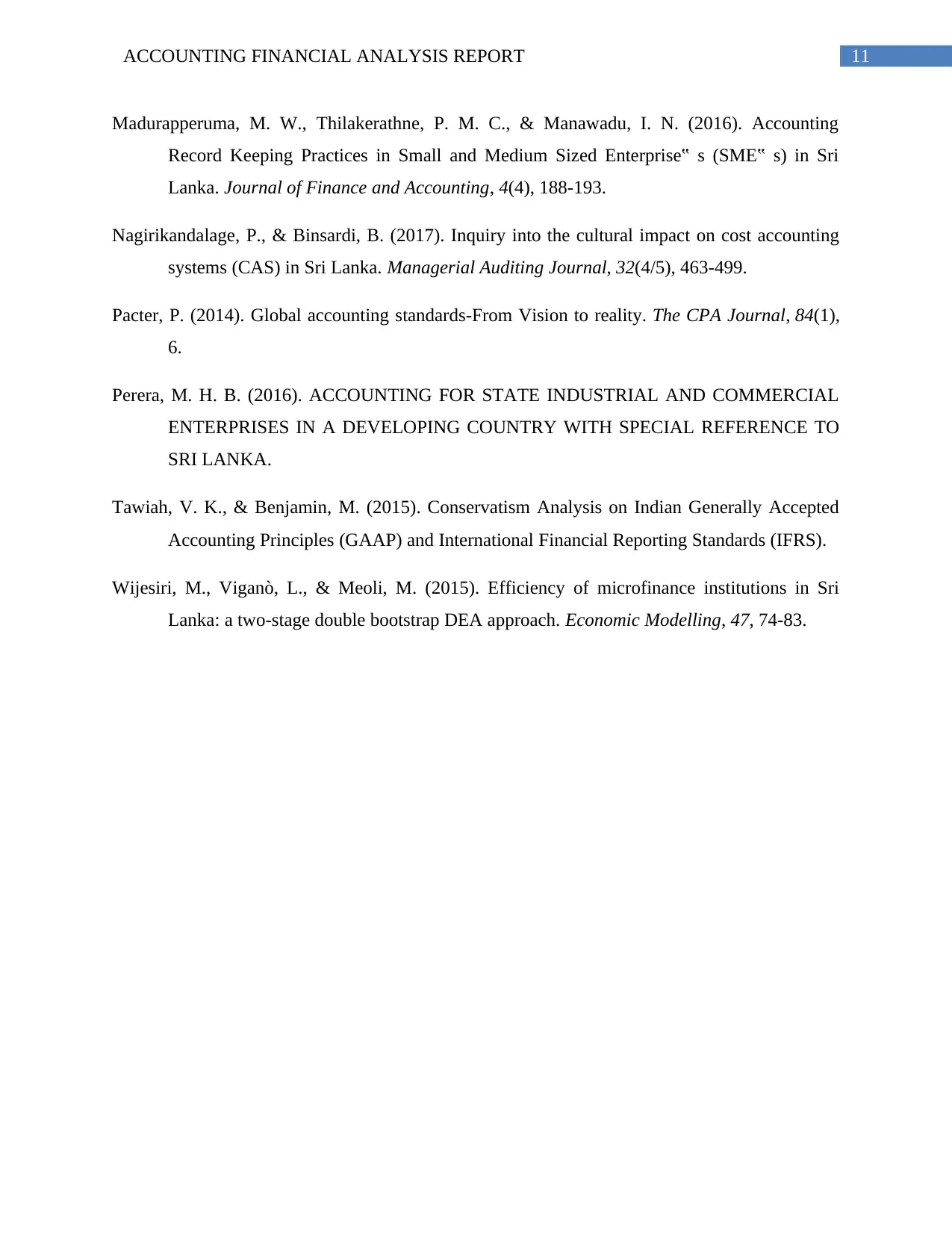
11ACCOUNTING FINANCIAL ANALYSIS REPORT
Madurapperuma, M. W., Thilakerathne, P. M. C., & Manawadu, I. N. (2016). Accounting
Record Keeping Practices in Small and Medium Sized Enterprise‟ s (SME‟ s) in Sri
Lanka. Journal of Finance and Accounting, 4(4), 188-193.
Nagirikandalage, P., & Binsardi, B. (2017). Inquiry into the cultural impact on cost accounting
systems (CAS) in Sri Lanka. Managerial Auditing Journal, 32(4/5), 463-499.
Pacter, P. (2014). Global accounting standards-From Vision to reality. The CPA Journal, 84(1),
6.
Perera, M. H. B. (2016). ACCOUNTING FOR STATE INDUSTRIAL AND COMMERCIAL
ENTERPRISES IN A DEVELOPING COUNTRY WITH SPECIAL REFERENCE TO
SRI LANKA.
Tawiah, V. K., & Benjamin, M. (2015). Conservatism Analysis on Indian Generally Accepted
Accounting Principles (GAAP) and International Financial Reporting Standards (IFRS).
Wijesiri, M., Viganò, L., & Meoli, M. (2015). Efficiency of microfinance institutions in Sri
Lanka: a two-stage double bootstrap DEA approach. Economic Modelling, 47, 74-83.
Madurapperuma, M. W., Thilakerathne, P. M. C., & Manawadu, I. N. (2016). Accounting
Record Keeping Practices in Small and Medium Sized Enterprise‟ s (SME‟ s) in Sri
Lanka. Journal of Finance and Accounting, 4(4), 188-193.
Nagirikandalage, P., & Binsardi, B. (2017). Inquiry into the cultural impact on cost accounting
systems (CAS) in Sri Lanka. Managerial Auditing Journal, 32(4/5), 463-499.
Pacter, P. (2014). Global accounting standards-From Vision to reality. The CPA Journal, 84(1),
6.
Perera, M. H. B. (2016). ACCOUNTING FOR STATE INDUSTRIAL AND COMMERCIAL
ENTERPRISES IN A DEVELOPING COUNTRY WITH SPECIAL REFERENCE TO
SRI LANKA.
Tawiah, V. K., & Benjamin, M. (2015). Conservatism Analysis on Indian Generally Accepted
Accounting Principles (GAAP) and International Financial Reporting Standards (IFRS).
Wijesiri, M., Viganò, L., & Meoli, M. (2015). Efficiency of microfinance institutions in Sri
Lanka: a two-stage double bootstrap DEA approach. Economic Modelling, 47, 74-83.
⊘ This is a preview!⊘
Do you want full access?
Subscribe today to unlock all pages.

Trusted by 1+ million students worldwide
1 out of 12
Related Documents
Your All-in-One AI-Powered Toolkit for Academic Success.
+13062052269
info@desklib.com
Available 24*7 on WhatsApp / Email
![[object Object]](/_next/static/media/star-bottom.7253800d.svg)
Unlock your academic potential
Copyright © 2020–2025 A2Z Services. All Rights Reserved. Developed and managed by ZUCOL.



